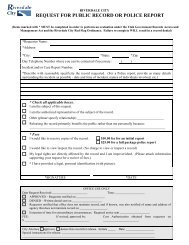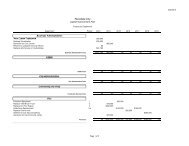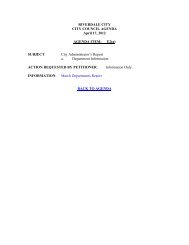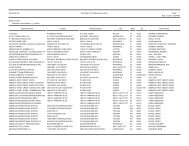Weber River Flood Damage Assessment - Riverdale City
Weber River Flood Damage Assessment - Riverdale City
Weber River Flood Damage Assessment - Riverdale City
Create successful ePaper yourself
Turn your PDF publications into a flip-book with our unique Google optimized e-Paper software.
<strong>River</strong>dale <strong>City</strong> 2011 <strong>Flood</strong> <strong>Assessment</strong> October 13, 2011<br />
Wetlands<br />
Adjacent to the <strong>Weber</strong> <strong>River</strong>, <strong>River</strong>Restoration identified three emergent wetlands. One wetland<br />
appears to be healthy and is located approximately 825 feet upstream of the Creekside Trail on the<br />
Parkway. This wetland has a robust diversity of species and appears to have adequate flow and<br />
oxygenation. The other two emergent wetlands have the potential to provide invaluable habitat and<br />
improve water quality but are in need of enhancement.<br />
The smallest and most downstream wetland is located adjacent to the North Trail Head. This wetland<br />
appears to be the associated with stormwater runoff from the adjacent area. This wetland drains under<br />
the <strong>Weber</strong> <strong>River</strong> Pathway just upstream of the Parker Rd. underpass. There is an abundance of algae<br />
and trash present in the wetland (Figure 12). This wetland may have insufficient flow to provide<br />
adequate oxygenation. The garbage should be removed and the mechanical drainage system should be<br />
inspected to ensure there is adequate flow through the wetland.<br />
Figure 12-North Trailhead Wetland<br />
The second emergent wetland is located approximately 550 ft upstream on the Parkway from the Great<br />
Salt Lake Brine Shrimp warehouse. This wetland appears to be a historic meander (or oxbow) that has<br />
been isolated from the river due to the trail construction (Figure 13). This wetland is completely<br />
covered with algae which reduces the amount of available oxygen. It is likely that this wetland is<br />
anoxic (lacking oxygen) below the surface. Additionally there is a substantial amount of concrete<br />
rubble dumped on the sides of the wetland. This concrete may have been placed there to protect the<br />
bank from erosion when this was an active channel. <strong>River</strong>Restoraion recommends reconnecting this<br />
wetland to the river with small culverts under the Parkway to improve its hydraulics as well as allow it<br />
to provide some level of backwater storage during flashy flood events. This wetland is unique within<br />
<strong>River</strong>dale <strong>City</strong> and has the potential to provide critical ecosystem functions as well as excellent<br />
educational (interpretive) opportunities. Removal of the concrete would also provide aesthetic benefits<br />
to the community.<br />
20






